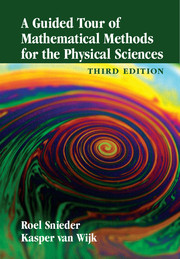Book contents
- Frontmatter
- Contents
- List of figures
- List of tables
- About the authors
- 1 Introduction
- 2 Dimensional analysis
- 3 Power series
- 4 Spherical and cylindrical coordinates
- 5 Gradient
- 6 Divergence of a vector field
- 7 Curl of a vector field
- 8 Theorem of Gauss
- 9 Theorem of Stokes
- 10 The Laplacian
- 11 Scale analysis
- 12 Linear algebra
- 13 Dirac delta function
- 14 Fourier analysis
- 15 Analytic functions
- 16 Complex integration
- 17 Green's functions: principles
- 18 Green's functions: examples
- 19 Normal modes
- 20 Potential field theory
- 21 Probability and statistics
- 22 Inverse problems
- 23 Perturbation theory
- 24 Asymptotic evaluation of integrals
- 25 Conservation laws
- 26 Cartesian tensors
- 27 Variational calculus
- 28 Epilogue, on power and knowledge
- References
- Index
12 - Linear algebra
Published online by Cambridge University Press: 05 March 2015
- Frontmatter
- Contents
- List of figures
- List of tables
- About the authors
- 1 Introduction
- 2 Dimensional analysis
- 3 Power series
- 4 Spherical and cylindrical coordinates
- 5 Gradient
- 6 Divergence of a vector field
- 7 Curl of a vector field
- 8 Theorem of Gauss
- 9 Theorem of Stokes
- 10 The Laplacian
- 11 Scale analysis
- 12 Linear algebra
- 13 Dirac delta function
- 14 Fourier analysis
- 15 Analytic functions
- 16 Complex integration
- 17 Green's functions: principles
- 18 Green's functions: examples
- 19 Normal modes
- 20 Potential field theory
- 21 Probability and statistics
- 22 Inverse problems
- 23 Perturbation theory
- 24 Asymptotic evaluation of integrals
- 25 Conservation laws
- 26 Cartesian tensors
- 27 Variational calculus
- 28 Epilogue, on power and knowledge
- References
- Index
Summary
In this chapter several elements of linear algebra are treated that have important applications in physics or that serve to illustrate methodologies used in other areas of mathematical physics. For example, linear algebra provides a foundation for the inverse theory presented in Chapter 22.
12.1 Projections and the completeness relation
In mathematical physics, projections play an important role. This is true not only in linear algebra, but also in the analysis of linear systems such as linear filters in data processing (Section 14.10), and in the analysis of vibrating systems such as the normal modes of the Earth (Section 19.7). Let us consider a vector v that we want to project along a unit vector n (Figure 12.1). In the examples in this section we work in a three-dimensional space, but the arguments presented here can be generalized to any number of dimensions.
We denote the projection of v along n as Pv, where P stands for the projection operator. In a three-dimensional space this operator can be represented by a 3 × 3 matrix. It is our goal to find the operator P in terms of the unit vector n, as well as the matrix form of this operator. By definition the projection of v is directed along n; hence,
Pv = Cn.
This means that we know the projection operator once the constant C is known.
Problem a Show that with the variables defined in Figure 12.1 the length of the vector Pv is |Pv| = |v| cos ϕ. Use (n · v) ≡ n|v| cosφ = |v| cos φ to show that C = (n · v).
Inserting this expression for the constant C in (12.1) leads to an expression for the projection
Pv = n (n · v).
Problem b Show that the component v⊥ perpendicular to n as defined in Figure 12.1 is given by:
v⊥ = v − n(n · v).
- Type
- Chapter
- Information
- A Guided Tour of Mathematical Methods for the Physical Sciences , pp. 166 - 187Publisher: Cambridge University PressPrint publication year: 2015



